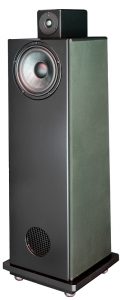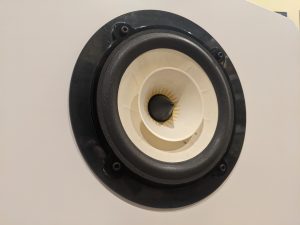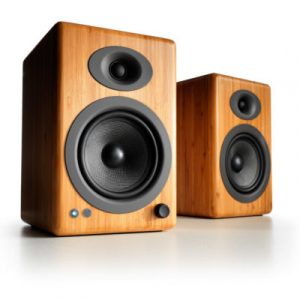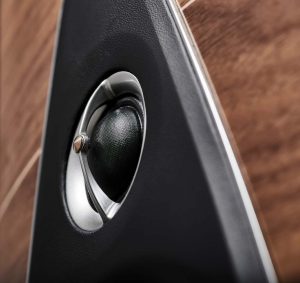A Funny Thing Happened on the Way to the Boudoir.
Since I moved into a very large loft some 20 years ago, my only rule for reviewing was NO MONITOR SPEAKERS! My listening room is 36' x 60' x 14'. Even some larger floor standers have suffered the anguish of trying to move all that air. Amps, preamps, integrated amplifiers, turntables, streamers, bring 'em on. Monitor speakers? No thank you.
Rich Maez, formerly with Boulder Amplifiers, now running Monarch Systems Ltd. distribution, brought up the possibility of reviewing the Chario Sonnet monitors, the top monitor in the Academy series ($8200 including stands). Despite my allergy to all things that are small speakers for my big room, there was a glimmer of an opportunity to set up a system in my bedroom that would accommodate the smaller stature of the Sonnet and even the playing field. My bedroom is a respectable 16' x 23'. But, due to it having a king sized bed, dressers, a couple of oddly angled walls and a home office, it's impossible to fit a floor stander adequately. When Rich offered to sweeten the deal arranging the new Boulder 866 integrated amplifier DAC/streamer to join the party, I couldn't resist.
If you have never heard of Chario, it's certainly not because they are a new company. Here are some relevant translated excerpts from the Chario 100 page Academy book about the Sonnet on the brand and its philosophies.
"The company was founded in 1975 by two engineers—CHArlie and MaRIO…hence the name. Both were scientists at the University of Milan and were just as interested in how humans hear relative to how loudspeakers work. The theoretical premise was that if you build a speaker that is optimized for test equipment, you may have been designing for the wrong audience. Likewise, tailoring a speaker for the human ear without technical knowledge regarding loudspeaker mechanics and acoustics prevents you from building a quality speaker that does what you want it to do.
"The Chario Sonnet resides in the Academy series (their top range) and all have a tweeter that can—and does—play cleanly down to approximately 1,000 Hz. (This is sort of an insanely low frequency for a tweeter. I'm not aware of many others that do this.) Humans are simply not receptive to phase distortions between 800 and 1500 Hz—the human body does not work that way due to the shape of the head, torso, ears, etc. Yet nearly all loudspeaker companies place the critical tweeter/midrange (or woofer) crossover point above this range where we're most sensitive to it because the tweeters they use only have this range available without distortion. Chario designed the T32 tweeter to be able to play well below the range we're sensitive to in order to avoid the problem altogether—if you put the crossover point where we can't hear the distortion, the result is that the Sonnet sounds as if it's a single-driver speaker.
"The Sonnet has this insanely broad tweeter range for another reason: high and mid frequencies have a narrow dispersion pattern and tend to beam or be directed at the listener by aiming the tweeter. Broadening the range of the tweeter results in less 'beaming,' and widens the dispersion of the high and mid frequencies, allowing the speaker to present a very broad sound field. Eliminate the crossover point = eliminate the audible distortion. Finally, low frequencies have a wide dispersion field, so mounting the woofer as far away from the assumed first reflection point—the floor—eliminates the reflective harmonic distortions discussed above. Since tweeters have narrower dispersion, they should be placed at ear height. Since woofers have wider dispersion, they should be mounted further away from the floor. Thus, the Chario Sonnet has the woofer mounted high and above the tweeter. This puts the woofer more than a meter above the floor's first reflection surface and eliminates the harmonic distortion that comes with it, while at the same time allowing the tweeter to be placed at ear-height for proper imaging focus.
"To sum up: three things achieved in the Sonnet: no crossover phase distortion between the tweeter and midrange because there is no crossover point—the tweeter plays low enough not to need one, and it crosses over to the woofer so low that we can't hear the crossover point. The tweeter is mounted at ear height where we get ideal imaging and high frequency response, and the woofer is mounted high to avoid the harmonically distorted first reflection from the floor."
So let's cast a gaze upon these beautiful speakers. The stands, while cutting a sophisticated profile, are contoured milled wood boxes, save the braces that screw into the bottom forming the floor supports, and the plate the secures the speaker to the stands, which are metal. I would really like to see a full metal stand as the edges of the wood pillars are sharp, delicate, and susceptible to dings. Due caution when assembling is advised.
When fully constructed they do indeed look beautiful. The cabinets are solid walnut, and all elements of the Sonnet are made in house. I personally love the natural finish of the walnut. If I owned them, I can imagine every so often giving them a gentle rub down with wood oil and a nice soft chamois! Short of that, every time I walk by them I stroke the top of the cabinet enjoying the tactile nature of that solid walnut.
Did I mention I set them up in the main living room instead of the bedroom? And that I ended up hooking them up to the Boulder 866 replacing my reference gear? I just couldn't resist. Like an Emperor throwing someone to the lions in the Colosseum for his amusement, I braced for the gruesome inevitable conclusion, a thumbs down. The Sonnets were spread 9 ft apart, 7 ft. from the front wall, no side walls anywhere to be found, and the rear wall some 16 ft behind the listening seat, they were in essence operating in free air. Hooking up my McIntosh MB50 streamer to the toslink input of the 866, I started off with Cowboy Junkies "Lay it Down." As I turned up the volume from a whisper, the sound field just grew and grew. Soon the volume was in full throat, and the Sonnets were not fighting back one bit. Not even addressing the quality of the sound, just the quantitative output capabilities seemingly down to the 50Hz range was staggering. No strain, no compression. The aluminum vapor deposited soft dome tweeter remained composed and the 6.69" Rohacell driver maintained excellent imaging and image separation. I was not prepared for this at all. Of course there wasn't quite the density and presence of the image of some of the 50, 70, 80K speakers that have come, stayed, or gone. But when a speaker is asked to do the impossible and completely over delivers, it's a rare joy to behold.
So we have a compact pair of solid walnut two-ways sounding way bigger than they should. That is great. But how does all that output actually sound? More good is good, more great is, in a word, spectacular. These are speakers that reveal the nature, the artist's intent, and the truth within the music. Listening to "Oh Darling" from Abbey Road, I was shook. I have listened to this track regularly for 40 plus years, and for some reason, through the Sonnets, I was so taken with what John Lennon was capable of doing with his voice. When he gets really worked up and begins to wail and shriek, the Sonnets simply reveal his instrument without adding any extra edge or hype to the texture of his voice. This really allows the full emotional impact and artistry to shine through unaltered. With the help of the Boulder's 866 incredible neutrality, transparency, and lack of digital artifacts, the Sonnets are capable of both very high resolution yet harmonically rich, warmish naturally colored timbre that revealed this often over looked aspect of Lennon's vocals. This is exactly what defines the high-end for me. Deeper insight into the music, not necessarily just fudging with the sound for sounds sake.
I was also surprised at how well the Sonnets are at revealing the size, and shape of each individual recording. From Damien Rices' close mic'd "Blowers Daughter" vocal that appears a bit bigger than life to Elton John's smaller more recessed vocal on "Rocket Man" from Good Bye Yellow Brick Road, the Sonnets simply passed on the signal as presented. "Candle in the Wind" beautifully unraveled the back ground harmonies, the voices rising and falling with ease untethered to the other mid-range instruments and set far back on the stage. Overall I'd call the presentation laid back, inviting you in the music's home rather than meeting you on the stoop.
The treble contributes immensely to the enjoyable nature of the Sonnet. The aluminum vapor coated soft dome tweeter is truly a masterpiece. Cymbals in particular sound amazing with convincing realism. Detail is so effortlessly presented and in great abundance. Every track I played that contained cymbals, even those that may have been too edgy on other speakers, took on a smoother though no less detailed presentation. Along with the corona plasma tweeter in my $55K Lansche 4.1, this has become my favorite tweeter on the planet.
The bass drops throughout "Lay it Down" are clear, textured and powerful. Even when the note is gently struck, you can hear and to a surprising extant feel the notes attack sustain and decay.
If there were an area where the Sonnet may require some extra care is in set up for the most even bass response, hardly unique for any speaker finding a new home. There were times where the mid bass sounded a touch bigger than the rest of the frequency range. On recordings where the mid bass was typically weak, the Sonnets sounded more fleshed out, but it would cut the other way when recordings had pronounced mid bass such as Stanley Clark's "Christmas In Rio" from If this Bass Could Only Talk, the mid bass could be a bit over blown. I was able to neutralize much of this by pulling the speaker further out into the room and angling the speaker more directly at my ears. Chario includes a detailed set up process in their book for rooms with more conventional dimensions.
From the jump, the Sonnets presented an engaging, inviting, detailed yet utterly natural timbre, and a sound stage that bloomed in all directions. With some added care, the frequency range was very smooth and linear with an overall warm balance. No, they will not replace my 500 lb Sunny Cable Majestic15, or my 50K Lansche 4.1 with 4 powered 10 inch bass drivers and Plasma tweeters. I can say that the $8K Sonnets possesses wholly unique qualities that even some of the big dollar designs don't possess in the same way. Ultimately what you get with the Sonnets add up to intense musicality, outstanding reproduction of timbre, great dynamic output, and effortless detail retrieval.
One can get some nice free from the box imaging from just about any competently designed monitor. It's just the nature and charm of the beast. What separates the Chario Sonnets, and really surprised me in addition to all the strengths mentioned, was not the pinpoint imaging, but the body fleshing out those images, and the copious volume of space rendered. These speakers breathe life into a recording in a very compelling way.
In the end, I did bring the Sonnets into the bedroom, and they did a fine job. but my experience in the big room was all I needed to get a handle as to what they were all about. I'm very glad I took the bait and challenged my long held beliefs regarding monitor speakers. This has been a wonderful eye opening experience. I can't say I'll take on many more small speakers for review, but as far as the Chario Sonnets are concerned, I'm impressed—very impressed. They definitely have piqued my interest in what Chario offers for a much larger room. Ultimately, the Sonnets are a feast for all the senses. Touch, sound, and vision, a true high-end experience. Even if you are looking at floor standing speakers at this price point, I'd strongly recommend considering the Chario Sonnet.
Sonnet Loudspeakers
Retail: $8200 including stands
Chario









































